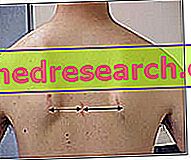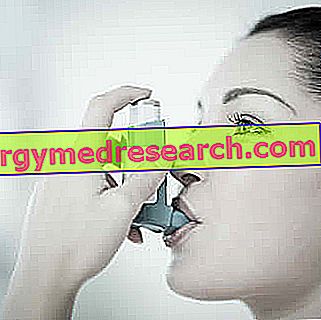Edited by Alessandro Giannetto
The most underestimated aspect, perhaps by most users and not only by attending fitness centers, is the "postural attitude" (posture). If we observe ourselves with the eyes of a blind person, we can well understand that these aspects do not concern us only for the simple fact that we lie psychologically to ourselves, believing that we are theoretically perfect when in reality we are far from it. Unfortunately, in the daily practice of training in the gym we are often looking for an "ideal aesthetic" result, sometimes not feasible if the right precautions are not taken to correct these structural defects. Equally frequently, some insiders insert in the training programs "fundamental exercises" that concern a very close circle of perfect or nearly perfect individuals. These instructors and personal trainers act in this sense for the simple fact that the request is to obtain a cover physicist, just like the one you notice on the sector magazines. In general, we see these exercises done by body-builders convinced that they are, often with the shadow of doping: bench presses with a barbell, slow forward / backward, deadlifts, squats, rowers, etc. Most of the time these individuals neglect a myriad of important aspects of training, without thinking about the "health future" of the "spine"; in particular, they do not seem to take care of "posture" and of possible "overload pathologies" such as the best known herniated disc in the lumbar fascia (from L1 to S1). All these artifices obscure the real important aspects of training, filtering only the side of muscle tonicity or trophism (hypertrophy) with the risk of causing a "relative aesthetic health". The much-neglected postural attitude is in fact the basis of our physicality, linked to the skeletal apparatus (frame) where the striated and voluntary skeletal muscles (musculoskeletal apparatus) rest; the correct posture is therefore the primary component of training and well-being and as such should be evaluated and monitored at a glance vigilant / clinical by each professional intent on drawing up a training workout.
An incorrect posture always indicates a problem of general structure, with repercussions on the weaker musculature areas; this imbalance leads to the non-global recruitment of the muscles affected by the work being done.

The term " winged shoulder blades " refers to a postural attitude present in almost 90% of clients, especially boys and girls of developmental age, that is between 12-14 years; given the pre-adolescent puberal crisis, to which is associated a remarkable structural increase in osteo-articular (proceritas secunda), in this period the winged scapulas represent the most present of the "paramorphisms of the rachis". We recall that at the clinical level the morphological bodily alterations are distinguished in paramorphisms and dysmorphisms; both are the result of positions maintained for vicious habits, with transient and correctable deformities with adequate gymnastics for paramorphisms, and not correctable in this sense in dysmorphisms; the latter, due to the chronicity created over time, require adequate surgical-orthopedic treatment.
The observation of subjects with a longer clavicular axis than the normal aolla is seen as a detachment between the "shoulder blades" which, lateralizing, make a broad and flat "back" appear on the posterior side of the "trunk". On the lateral view is instead perceived an obvious flatness both of the "back" and of the "chest" and from the frontal one an insufficient / poor tropism of the "pectoral muscles"; but a wider "back". The scapulae outside or winged scapulae are therefore the result of a detachment of the same from the chest towards the front, normally bilaterally. This is the basic attitude, but in some subjects there is a decidedly smaller clavicular axis associated with "spine kyphosis" of the dorsal tract (t1-t12); consequently there is a marked protrusion of the shoulder blades that make the back curved: "curved back". These retractable paramorphisms in "Chicken wings or cat's back" do not allow the development of the "pectoralis major" muscle due to the imposition of the shoulder stumps. The pectoral muscles are the adductor muscles of the humerus and due to their biarticularity they are brought forward by opening the thoracic bachelor articulation (virtual articulation that marks the step / distance between one scapula and the other). Given the modified structure of the vertebral column and the clavicles, between the last cervical vertebra (c7) and the thoracic tract, there is a shortening of the pectoral muscles, which become unable to relax completely; the muscle can therefore only undergo partial lengthening, to the point of halving its effective force against the anterior shoulder muscles (anterior deltoid) and the posterior muscles - extensors of the arm (brachial triceps).

Having said that, let us now turn to the aspect of the training of the muscular section which allows the approach of the "shoulder blades"; which hypotoniacs, it will be necessary to work on: "central trapezoid" (superficial muscle) and "rhomboid" (deep muscle placed under the trapezius muscle). From the point of view of a good functioning it is good not to forget, indeed to keep in mind, also the involvement of the "posterior deltoid" muscle and the large dentate (deep muscle), due to its involvement on the humerus.
After these descriptions I wish I had made you aware of the importance of not neglecting the back muscles. A gradually improved posture could take from 1 month to about 1 year of training to consolidate the results (depending on the age of the subject, the muscles react differently). This intervention will allow not only to bring general trophism to all muscle regions, but will confer an aesthetic harmony with the benefit of a better social entrance, supported by a renewed self-confidence (remembering that body and mind are inseparable units).
I conclude that the path of muscle development will take you far more than you can imagine, as long as you adopt the exercises for your physical-genetic possibilities, reducing your workload and excluding the fundamental exercises for muscle development, in order to preserve the osteo-articular health.
In greeting you, I wish everyone a good posture.



